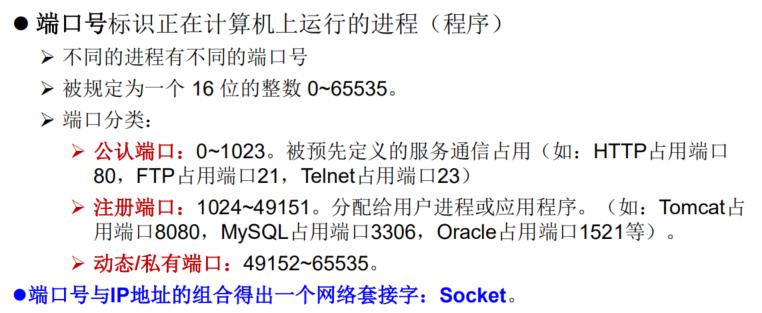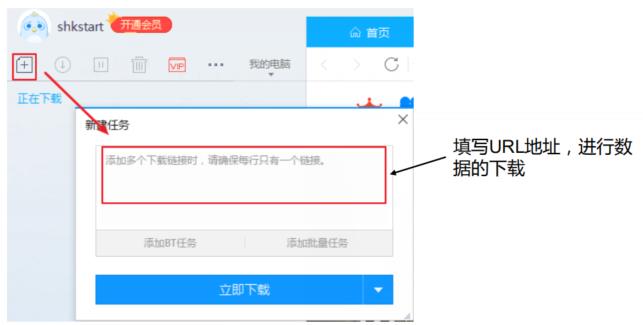Java学习总结(2021版)---网络编程基础
Posted 亿钱君
tags:
篇首语:本文由小常识网(cha138.com)小编为大家整理,主要介绍了Java学习总结(2021版)---网络编程基础相关的知识,希望对你有一定的参考价值。
网络编程基础
一:概述
-
网络编程的目的: 直接或间接地通过网络协议与其它计算机实现数据交换,进行通讯
-
实现网络通信需要解决的两个问题:
- 如何准确地定位网络上一台或多台主机;定位主机上的特定的应用
- 找到主机后如何可靠高效地进行数据传输
二:网络通讯要素
- 解决问题一:IP和端口号
- 解决问题二:提供网络通信协议:TCP/IP参考模型(应用层、传输层、网络层、物理+数据链路层)
通讯要素一:IP和端口号
IP的理解
- IP:唯一的标识 Internet 上的计算机(通信实体)
- 在Java中使用InetAddress类代表IP
- IP分类:
- 方式1:IPv4 和 IPv6
- 方式2:公网地址( 万维网使用)和 私有地址( 局域网使用)
- 域名: 通过域名解析服务器将域名解析为IP地址 www.baidu.com www.mi.com www.jd.com
- 域名解析:域名容易记忆,当在连接网络时输入一个主机的域名后,域名服务器(DNS)负责将域名转化成IP地址,这样才能和主机建立连接。
- 本地回环地址(hostAddress):127.0.0.1 主机名(hostName):localhost
- Internet上的主机有两种方式表示地址:
- 域名(hostName):www.baidu.com
- IP 地址(hostAddress):202.108.35.210
端口号:

InetAddress类

- 域名容易记忆,当在连接网络时输入一个主机的域名后,域名服务器(DNS)
负责将域名转化成IP地址,这样才能和主机建立连接。 -------域名解析

- 常用的方法

代码实例:
public static void main(String[] args)
try
//通过域名来获得InetAddress实例
InetAddress inet2 = InetAddress.getByName("www.baidu.com");
System.out.println(inet2);//www.baidu.com/39.156.66.18
//通过ip来获得InetAddress实例
InetAddress inet3 = InetAddress.getByName("127.0.0.1");
System.out.println(inet3);//127.0.0.1
//获取本地InetAddress实例
InetAddress inet4 = InetAddress.getLocalHost();
System.out.println(inet4);//DESKTOP-EV2S7MJ/10.1.1.127
//getHostAddress()获取主机域名
System.out.println(inet2.getHostName());//www.baidu.com
//getHostAddress();获取主机的ip地址
System.out.println(inet2.getHostAddress());//39.156.66.14
catch (UnknownHostException e)
e.printStackTrace();
通信要素二:网络通信协议
TCP协议 和 UDP协议

- 三次握手:确保通信对方在线
- 四次握手:确保连接断开
Socket

-
Socket类的常用构造器:
- public Socket(InetAddress address,int port)创建一个流套接字并将其连接到指定 IP 地址的指定端口号。
- public Socket(String host,int port)创建一个流套接字并将其连接到指定主机上的指定端口号。
-
Socket类的常用方法:

三:TCP网络编程
1:简述
Java语言的基于套接字Socket编程,分为客户端和服务端
2:客户端Socket的工作过程包含以下四个基本的步骤:

- 注意:客户端程序可以使用Socket类创建对象,创建的同时会自动向服务器方发起连
接
3:服务器程序的工作过程包含以下四个基本的步骤:

4:举例:

代码实例1:----- 客户端发送信息给服务端,服务端将数据显示在控制台上
import org.junit.Test;
import java.io.ByteArrayOutputStream;
import java.io.IOException;
import java.io.InputStream;
import java.io.OutputStream;
import java.net.InetAddress;
import java.net.ServerSocket;
import java.net.Socket;
import java.util.Objects;
/**
* 实现TCP的网络编程
* 例子1:客户端发送信息给服务端,服务端将数据显示在控制台上
*/
public class TCPTest1
//客户端
@Test
public void client()
Socket socket = null;
OutputStream os = null;
try
//1.创建Socket对象,指明服务器端的ip和端口号
InetAddress inet = InetAddress.getByName("192.168.14.100");//获取此IP地址的主机名
socket = new Socket(inet,8899);
//2.获取一个输出流,用于发送数据给服务器
os = socket.getOutputStream();
//3.写出数据的操作
os.write("你好,我是客户端mm".getBytes());
catch (IOException e)
e.printStackTrace();
finally
//4.资源的关闭
if(os != null)
try
os.close();
catch (IOException e)
e.printStackTrace();
if(socket != null)
try
socket.close();
catch (IOException e)
e.printStackTrace();
//服务端
@Test
public void server()
ServerSocket ss = null;
Socket socket = null;
InputStream is = null;
ByteArrayOutputStream baos = null;
try
//1.创建服务器端的ServerSocket,指明自己的端口号
ss = new ServerSocket(8899);
//2.调用accept()表示接收来自于客户端的socket(监听一个客户端的连接)
//该方法是一个阻塞方法,如果没有客户端连接将一直等待
socket = ss.accept();
//3.获取输入流,用来接收客户端发送的数据
is = socket.getInputStream();
//不建议这样写,可能会有乱码
// byte[] buffer = new byte[1024];因为此处长度如果小于接受数据的长度,导致分成两半,后续用String接收会乱码
// int len;
// while((len = is.read(buffer)) != -1)
// String str = new String(buffer,0,len);
// System.out.print(str);
//
//4.读取输入流中的数据
//因为此处如果小于接收的数据长度,并不会单独还原成字符串,而是先拼起来整体再还原
baos = new ByteArrayOutputStream();
byte[] buffer = new byte[5];
int len;
while((len = is.read(buffer)) != -1)
/**ByteArrayOutputStream源码
* public synchronized void write(byte b[], int off, int len)
Objects.checkFromIndexSize(off, len, b.length);
ensureCapacity(count + len);
System.arraycopy(b, off, buf, count, len);
count += len;
*/
//把数据写到baos对象,以便后续整体还原
baos.write(buffer,0,len);
/**ByteArrayOutputStream源码
* protected byte buf[];
*/
/**
* public synchronized String toString()
return new String(buf, 0, count);
*/
//把内部字节字符直接转换成字符串
System.out.println(baos.toString());
System.out.println("收到了来自于:" + socket.getInetAddress().getHostAddress() + "的数据");
catch (IOException e)
e.printStackTrace();
finally
if(baos != null)
//5.关闭资源
try
baos.close();
catch (IOException e)
e.printStackTrace();
if(is != null)
try
is.close();
catch (IOException e)
e.printStackTrace();
if(socket != null)
try
socket.close();
catch (IOException e)
e.printStackTrace();
if(ss != null)
try
ss.close();
catch (IOException e)
e.printStackTrace();
代码实例2:----- 从客户端发送文件给服务端,服务端保存到本地。并返回“发送成功”给客户端
/*
这里涉及到的异常,应该使用try-catch-finally处理
*/
public class TCPTest3
@Test//客户端
public void client() throws Exception
//创建Socket对象,指明服务器端的ip和端口号
InetAddress inet = InetAddress.getByName("127.0.0.1");
Socket socket = new Socket(inet,9090);
//获取输出流,用来发送数据给服务器
OutputStream so = socket.getOutputStream();
FileInputStream fis = new FileInputStream(new File("one.jpg"));
byte[] buffer = new byte[1024];
int len;
//将从文件中读取的数据发送给服务器
while((len = fis.read(buffer)) != -1)
so.write(buffer,0,len);
//关闭数据的输出,会在流末尾写入一个“流的末尾”的标记,服务器才能读到-1,否则对方的读取会一直阻塞
socket.shutdownOutput();
//接收来自服务器端的数据,并显示到控制台上
InputStream is = socket.getInputStream();
ByteArrayOutputStream baos = new ByteArrayOutputStream();
System.out.println("我想接收来自服务器的数据");
while((len = is.read(buffer)) != -1)
baos.write(buffer,0,len);
System.out.println(baos.toString());
//关闭流
baos.close();
is.close();
fis.close();
so.close();
socket.close();
@Test//服务器
public void server() throws Exception
ServerSocket ss = new ServerSocket(9090);
Socket socket = ss.accept();
InputStream is = socket.getInputStream();
FileOutputStream fos = new FileOutputStream(new File("three.jpg"));
byte[] buffer = new byte[1024];
int len;
while((len = is.read(buffer)) != -1)
fos.write(buffer,0,len);
//服务器端给与客户端反馈
OutputStream os = socket.getOutputStream();
os.write("你好,文件我已经收到".getBytes());
//关闭流
os.close();
fos.close();
is.close();
socket.close();
ss.close();
四:UDP网络编程(了解)
五:URL编程------它表示 Internet 上某一资源的地址

概述:

URL的基本结构由5部分组成:

URL类常用方法:

代码示例:
public class URLTest
public static void main(String[] args)
try
URL url = new URL("http://localhost:8080/examples/beauty.jpg?username=Tom");
// public String getProtocol( ) 获取该URL的协议名
System.out.println(url.getProtocol());
// public String getHost( ) 获取该URL的主机名
System.out.println(url.getHost());
// public String getPort( ) 获取该URL的端口号
System.out.println(url.getPort());
// public String getPath( ) 获取该URL的文件路径
System.out.println(url.getPath());
// public String getFile( ) 获取该URL的文件名
System.out.println(url.getFile());
// public String getQuery( ) 获取该URL的查询名
System.out.println(url.getQuery());
catch (MalformedURLException e)
e.printStackTrace();
以上是关于Java学习总结(2021版)---网络编程基础的主要内容,如果未能解决你的问题,请参考以下文章